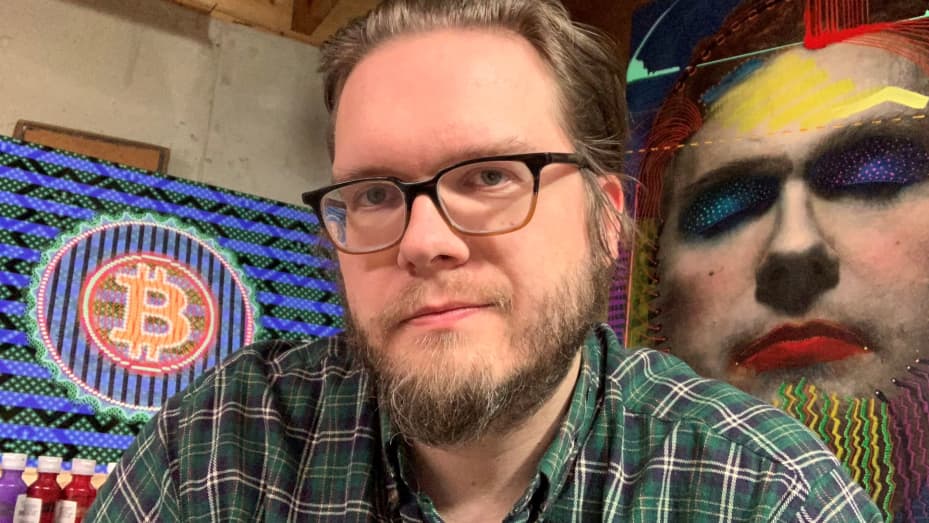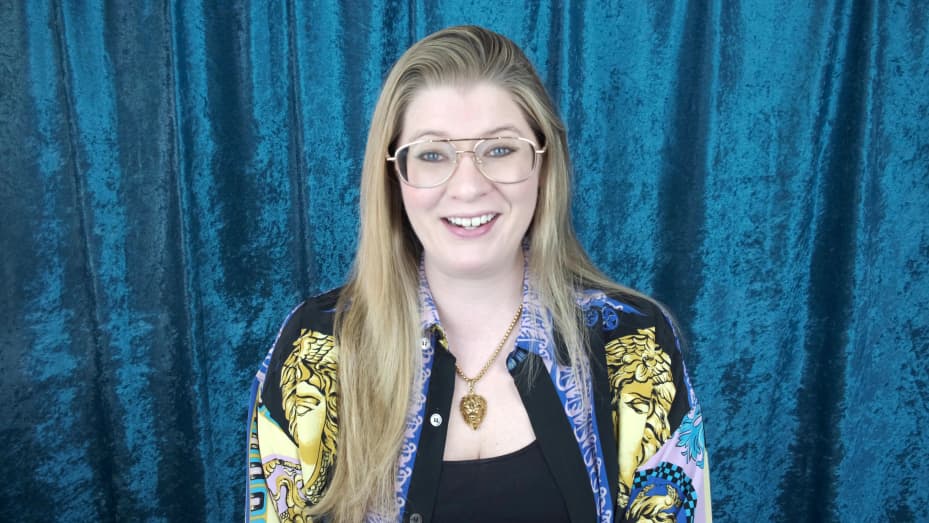Digital artist Sarah Zucker started selling NFTs of her art work in 2019 when no one but the crypto community knew what an NFT even was. Then, within a year, it became her main source of income.
In 2021, Zucker has had over $274,000 in NFT sales already.
And Zucker isn’t alone.
The latest NFT hype cycle has led to billions of dollars in sales this year. Celebrities – from athletes like NFL player Rob Gronkowski, to musicians like Shawn Mendes and executives like Tesla’s Elon Musk – have cashed in on the craze with drops of their own.
And there have been record-breaking auctions like artist Beeple’s, who sold his NFT “Everydays: The First 5000 Days” for over $69 million.
But there are also everyday creators making an impressive living off of NFTs, who are using the technology to take control of their art and careers.
“You have to realize that behind the $69 million sales…there’s very modest prices that are supporting a lot of legitimate artists,” says artist Matt Kane.
Meet three creators making more money than they ever have before thanks to NFTs.
‘I was able to really create my own career’
Marguerite deCourcelle, known as Coin Artist, first got into crypto art when she used images of her oil pastel paintings to create a series of digital puzzles in 2014. One of her most famous, “The Legend of Satoshi Nakamoto” — a nod to the creator/s of bitcoin — went viral within the crypto community, and when solved, unlocked bitcoin prizes.
With her success, deCourcelle dreamed of creating a crypto-game development company, but the blockchain-based assets available at the time were not advanced enough to support her vision, she says.

Marguerite deCourcelle’s in-game Neon District character that she sold as an NFT.Courtesy of Marguerite deCourcelle
Then, in 2017, CryptoKitties launched. The Ethereum-based game allows users to collect NFTs of digital cats.
Impressed with the technology, deCourcelle and her team used NFTs to create blockchain-based games through her studio, Blockade Games, which launched in 2018. Its flagship game, Neon District, allows users to earn and buy in-game NFT items, like gear for characters.
Blockade Games has made over $333,000 this year, deCourcelle says, and Neon District has generated over $195,000 this year by monetizing NFTs as game assets.
A previously struggling artist, deCourcelle “was able to dig myself out of that and really create my own career,” says the 35-year-old, who is now considered a pioneer in the space. “I was able to actually really invest in myself, in my own career and what I wanted to do to take control of my life.”
DeCourcelle has also made money selling her art as NFTs – about $212,000 in 2020. But she shifted her full attention to her business this year – with the exception of one major project: In May, Christie’s will auction an NFT of a piece that she is co-creating.
With NFTs, artists are able to tokenize, own and profit from their digital pieces. So “you’re unlocking a whole bunch of people that have never been able to monetize with digital art, which is incredible,” she says. “And that’s why people are so excited about it.”
Royalties are ‘critical’
These days, Chicago-based artist Kane sells NFTs of his work as his main source of income.
When he first started selling his work in the 2000s, Kane, now 40, sold oil paintings. But, over the years, he taught himself how to code so he could make software to create his art. With it, Kane began to sell crypto art in early 2019.

Artist Matt Kane.Courtesy of Matt Kane
At first, he did not earn a comparable profit to his physical art – his NFTs sold for hundreds of dollars, whereas his traditional paintings sold for thousands.
But, as his collector base grew, “suddenly, in November 2019, I was able to sell an NFT for over $1,000,” he says.
“This was life changing for me. I was able to make different plans for my future just on that. And that’s a very modest price,” he says.
Within a year, sales of his digital art began to steadily match his typical rates. In September 2020, Kane was able to reach a major milestone in selling an NFT of his piece, “Right Place & Right Time,” for over $100,000, which was record-setting then. (It’s complex, but due to the NFT’salgorithm and the way Kane programmed it, “Right Place” was in high demand.)

“8 minutes 46 seconds – In Memoriam George Floyd” by Matt Kane, which he sold and donated all proceeds to Campaign Zero, a nonprofit organization focused on ending police violence.Courtesy of Matt Kane
“For the last seven years, I had basically gone through my life savings, building my custom software, embarking on this dream of becoming a digital artist,” Kane says. “To make such a historic sale, there was confirmation that I wasn’t crazy. It felt good.”
This year, Kane has already made over $131,000 in NFT sales, he says.
But in addition to primary sales, thanks to NFTs, Kane and other artists are now able to profit from secondary sales via royalties – due to smart contracts on the blockchain, creators can earn additional compensation as their NFTs are resold.
“Because of my experience with brick and mortar galleries, I understood that royalties are a critical part,” Kane says, as traditionally, artists do not benefit from the sometimes multimillion-dollar resales of their work. “Artists need to participate in their own success that they create. It’s only fair.”
Using smart contracts, Kane requires a royalty of at least 10% on secondary sales. So far this year, Kane has earned over $13,000 from royalty payments on secondary sales, he says.
NFTs ‘changed the trajectory of my art career’
Sarah Zucker first learned about the potential for something like NFTs when the Ethereum blockchain (which powers most NFTs) launched in 2015.

Digital artist Sarah Zucker.Courtesy of Sarah Zucker
At the time, Zucker primarily sold fine art photography at galleries but realized that the technology could one day help her sell digital art, like the gif art she had been creating since 2011.
With smart contracts that run on Ethereum, NFTs are documented and certifiable on the blockchain. Zucker knew this would give her work “publicly verified provenance,” something that had not been possible before, she says.
Zucker remembers thinking, “wow, that’s gonna make a big difference for me. I’m going to keep my eyes and ears open.”
In 2019, after noticing another artist using NFTs, Zucker, who makes psychedelic, VHS and analog-style digital art, minted (or blockchain verified) her first NFT on platform SuperRare.

“Most Everyone’s Mad Here” by Sarah Zucker.Courtesy of Sarah Zucker
Her earliest tokens sold for around $50 to a few hundred dollars. Then, as she began to drop her work on platforms like Rarible, Nifty Gatewayand Foundation, her work started to attract more collectors.
In September 2020, “I started to see my single editions selling for much higher prices, and things just took off,” Zucker says.
For example, on April 22, Zucker dropped a collection called “The Cassandra Complex” on a new platform called Blank.Art. Every available work within the collection sold within a day, and she made about $97,000 in profit after fees, she says.
This year, Zucker has made over $238,000 in total profit after fees from NFTs, she says, with around $274,000 in total sales. That’s more than she made when selling her physical art, she says.
“It really is just one of those funny before and after things – this whole experience changed the trajectory of my art career and my life.”




Recent Comments